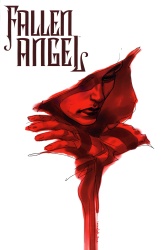The current tenuous situation with Fallen Angel reminds me of one of those curiosities of the comic book market: the relationship between episodes in magazine form and longer stories in book form.
Most comics in the US/Canadian market are released as individual issues, with maybe 22 pages of story and a bunch of ads. Longer works are often released as trade paperbacks (TPBs), but often don’t sell as well because, let’s face it, $19.95 is a much bigger chunk of change than $2.50. However, many series are collected into TPBs once the publisher figures the original issues have mostly been tapped out, often adding additional material like sketches, character designs, or occasionally an entire epilogue. (Kingdom Come and Death: The High Cost of Living both used that trick.) Advantages: they fit on a shelf, they’re often better paper and more durable, you can get an entire 6-part story in one chunk… and most importantly, they can fit on bookstores’ shelves, bringing them to an entirely new audience.
During the 1990s, only the most popular storylines would get the TPB treatment, but as the graphic novel market has grown, the trend has been toward collecting every issue of a series, so that whether you get the original issues or the collections, you still get everything. This has led to two controversial phenomena: writing for the trade and waiting for the trade.
The first is essentially a legacy from the earlier policy of just collecting major storylines. People look at a ½″-thick book and expect one long story—a graphic novel, as it were, rather than a collection of graphic short stories. So some writers take advantage of the wider canvas, and others stretch out 2-part stories to 3 parts or more, trying to hit the right length for the book.
The second is when someone knows the story will be collected, and chooses to skip the issues as they come out and, well, wait for the trade. When you’re 100% certain there will be a trade, it works. You’re part of the bookstore audience. The problem is with series that make borderline sales. If the issues don’t sell, the publisher might assume there’s no audience for the book, and not bother to print it. So there is no trade to wait for, the series disappears, and everyone’s left wondering what happened to the book everyone seemed to like, but no one actually bought.
In many ways, waiting for the trade is a gamble. If a series is popular, and the collections are selling well, it’s an easy bet. If it’s a genre that’s known to sell well in books (manga, for instance), it’s probably safe. You won’t have much trouble waiting for the next Powers or Fables collection, and there’s always a good chance that the year’s obligatory crossover event is going to get collected. But publishers are sometimes funny about what makes it into a collection even on popular series, and the niche ones don’t always make it to press.
Back to Fallen Angel briefly: When book 1 came out, DC wasn’t sure if they were going to release a second collection. After sales picked up over the last few months, they have at least decided to issue a second printing of the first book. But there’s still no word as to whether issues #7-12 will ever be collected, never mind #13-18. It all depends on whether DC thinks there’s enough of an audience.


